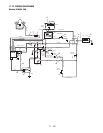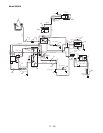11 - 47
Step 2:
Use a voltmeter to make sure you have power
to terminal (B) on the back side of the ignition switch in
the off position. If you don’t have power to terminal (B)
check the battery connections and the fuse in the red
lead.
Step 3
: With the ignition switch in the "run" position,
check to see if power has been transferred from
terminal (B) to terminal (A). Terminal (A) on the ignition
switch supplies power to the back of the PTO switch on
the purple lead and on to the brake switch on the
brown/yellow lead out of the brake switch on the red/
violet lead to the start light and to terminal (S2) on the
ignition switch and to terminal 86 on solenoid #2.
Terminal (A) also supplies power to terminal 30 and
terminal 86 on solenoid #1 and to the hour meter, and
the voltage sensor and sensor light. When the operator
is in the seat, power will transfer from terminal 30 to
terminal 67 and on to the front PTO switch, and on to
terminal 86 on the solenoid #2 in the yellow/red lead
and on to the cruise control switch. Power is supplied
to the fuel shut off solenoid from terminal 86 on
solenoid #2.
Step 4:
With the ignition switch in the start position,
power is transferred from terminal (S2) to (S1).
Terminal solenoid and goes to ground through the base
of the starter solenoid.
Clutch check out:
Remove the clutch lead to the
wiring harness and check the clutch with a VOM for
field resistance to see if the coil is good (3.0 - 3.9). If
bad, the resistance will be high or not at all.
Ignition switch check out:
Voltage check out in the
"off" position, check for voltage at terminal B. Voltage
should not be present on terminals A, S1, S2.
With the ignition switch in the "run" position, check for
voltage at terminals B, A, S2. It should not be present
on terminal S1.
With the ignition switch in the "start" position, check for
voltage at terminals B, A, S2, S1.
PTO switch check out:
The PTO switch is a push/pull
switch with straight across contacts. Power transfer
should be checked with a voltmeter. The switch
contacts should be checked with an Ohm meter with
the wire harness plug removed. The light switch is
similar to the PTO switch with only one contact.
Diode check out
: Diodes are checked with an Ohm
meter set on diode check, and should pass voltage in
only one direction. If a diode passes voltage in both
directions or not at all the diode is defective and will
need to be replaced.


















